The EVGA 7300 GS: A New Quality Budget Card From NVIDIA
by Josh Venning on February 20, 2006 12:23 PM EST- Posted in
- GPUs
Test Setup/High Quality Performance
Now that we've talked about the card, let's look at the performance. We've included a few other budget cards for comparison to get an idea of how the 7800 GS fits into the market. Included on the graphs, we have the Radeon X1300 (450MHz/500GHz), and X300, as well as NVIDIA's 6200 TC. The games that we are testing are Halflife2 Lost Coast, Battlefield2 and Quake4, at 800X600, 1024x768, and 1280x1024 resolutions. Here is the test system that we used:
*Note that sound was disabled for these tests.
Battlefield 2 Performance
Now that we've talked about the card, let's look at the performance. We've included a few other budget cards for comparison to get an idea of how the 7800 GS fits into the market. Included on the graphs, we have the Radeon X1300 (450MHz/500GHz), and X300, as well as NVIDIA's 6200 TC. The games that we are testing are Halflife2 Lost Coast, Battlefield2 and Quake4, at 800X600, 1024x768, and 1280x1024 resolutions. Here is the test system that we used:
| Testbed | |
| Processor: | AMD Athlon 64 FX-55 2.6 GHz Processor |
| Memory: | 1 GB OCZ 2:2:2:6 DDR400 RAM |
| Motherboard: | NVIDIA nForce 4 |
| Hard Drive: | Seagate 7200.7 120 GB |
| Power Supply: | OCZ 600 W PowerStream |
*Note that sound was disabled for these tests.
Battlefield 2 Performance


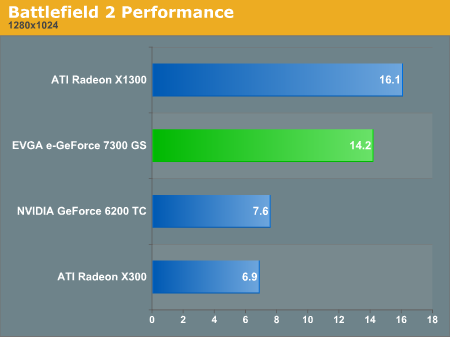
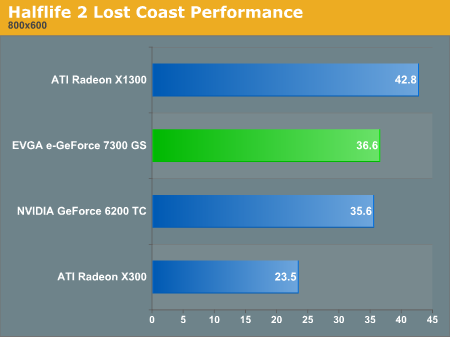
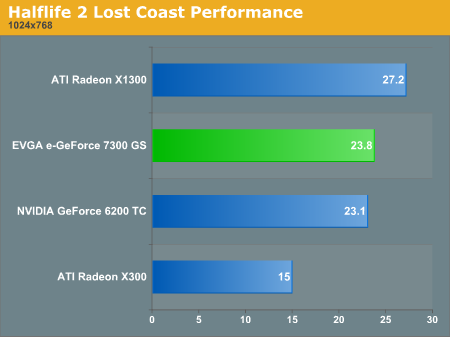


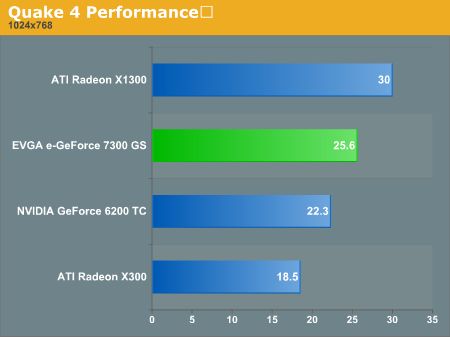
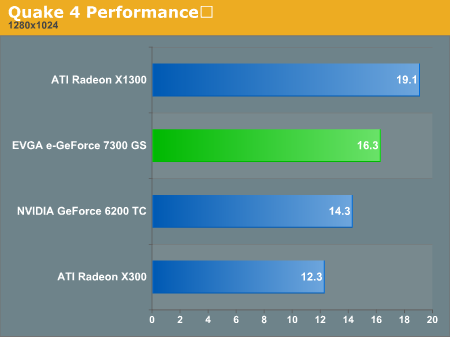










48 Comments
View All Comments
coldpower27 - Monday, February 20, 2006 - link
I think Anandtech dropped the ball a little on being specific on which models was tested with the cards, and exactly what clockspeed it was, you could at least have it very nicely explain on the Test Setup page, and not have us to look for it in the article for ease sake.I did see the clockspeed in the article itself but would prefer a list in the Test Setup page.
maxstr - Monday, February 20, 2006 - link
I would like to see comparison between the 7300 and the 6800. Is it an upgrade?coldpower27 - Monday, February 20, 2006 - link
No. It is not, this card get beaten by the Geforce 6600, let alone the 6800 Series. IF your looking at an upgrade to the 6800 go to a 7800 so you will actually see a performance improvement.
kmmatney - Monday, February 20, 2006 - link
"The 7300 GS also has 3 vertex and 4 pixel pipelines, the same as the 6200, but our EVGA 7300 GS has a larger memory size of 256 MB verses 16-64 MB of the 6200TC"Does this mean this card has 256 MB of on-board memory, or is that the amount of system memory it can use? Please explain.
coldpower27 - Monday, February 20, 2006 - link
This Geforce 7300 GS Series is currently limited to 128MB or 256MB of memory, and through TC can be marketed as a 256MB or 512MB card thru TurboCache using system memory.The Geforce 6200 TC Series was limited to 16MB, 32MB, 64MB of actual memory and could be marketed as a 128MB or 256MB card through TruboCache using system memory.
yacoub - Monday, February 20, 2006 - link
I'll never understand all the talk about low to mid range cards for budget tight people and then you test it with a friggin' FX-55. lolcoldpower27 - Monday, February 20, 2006 - link
Eliminate all other variables, other then 1 single conponent so you can see the effect said 1 conponent has on performance rather then try to deduce the effect the processor has in addition to the video card. It a very logical scientific approach.yacoub - Monday, February 20, 2006 - link
garbage and it's tiring seeing this misconception continually foisted in the article comments at this site.on its own, it's utterly irrelevant data to those who might actually purchase such a card. it would be useful as an ADDITION to an actual test with a modern mid-range system which would provide the MOST USEFUL numbers to folks looking at what GPU to buy to spruce up their S754 / S939 3000+-3200+ / P4 2.8GHz-3.2GHz system.
People who already have their system and just want to upgrade the GPU need to know one thing: What GPU will help them get the most fps improvement in the games they play on THEIR system - a midrange system - before diminishing returns kicks in and the price-to-performance-gained ratio drops off (ie, buying an X1900XTX for $550 might not gain them many more fps than buying a $250 7800GT simply because their cpu is limiting them once they own a card above a 7800GT. Thus, the important thing for them to see is how each GPU performs on a midrange system playing the games they play at their resolutions (likely 1024x).
How the card does on a cpu-unlimited system only tells part of the story and not the most important part at that.
yacoub - Monday, February 20, 2006 - link
to continue the point: if I have a midrange system, and i want to know which GPU to pick up to get the most out of the gpu upgrade, the data most important to me is how each GPU out there will perform in my midrange system. if, to continue the previous example, i find out that going above a 7800GT isn't going to gain me a significant improvement in fps, yet obviously the price goes up, I then know the 7800GT is the card to buy to get the most out of my current system as far as GPU is concerned.Clearly being a GPU review we're concerned with how the GPU performs. That's fine, but then in your conclusion you can only recommend which card is best for an FX-55 system. If the only part I want to upgrade on a mid-range system is the GPU, this article would be perfect for information for me - IF it actually used a mid-range system in the tests. Then I could see how this card fills into the ranks of GPUs out there as I seek to find the one that offers the most bang-for-the-buck (fps-for-the-dollar).
i hope this is comprehensible for everyone. in the past some folks here simply don't get it and only care to see dick measuring contests for individual pieces of hardware and never a useful review for the consumer who would actually use a given piece of hardware.
again, it's a nice review for what it is (a hardware dick measurement, aka no-limitations benchmark), but it's not all that helpful for folks in the real world.
coldpower27 - Monday, February 20, 2006 - link
This isn't a CPU scaling analysis to provide useful data to you to see how this GPU would effect different processor that I think can be done in another article, that would provide the useful infromation you seek. I don't think the article is garbage, the method is sound. The information your asking for would be another article entirely.